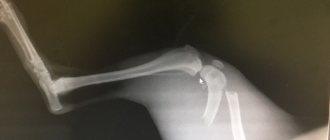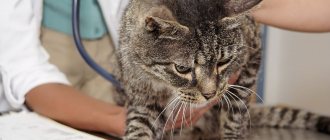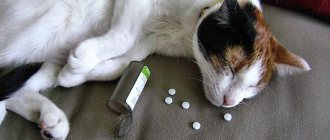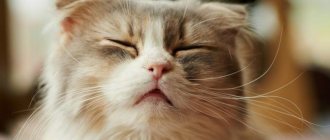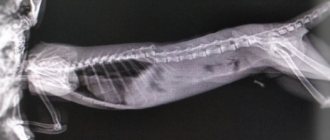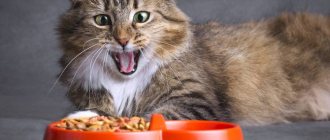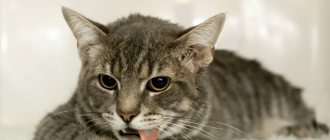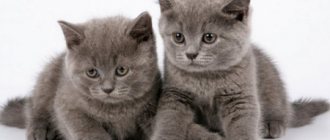Diarrhea in kittens can be a symptom of an infectious disease or indicate poisoning by toxic substances. An upset stomach causes rapid dehydration, which can cause your pet to die. Therefore, it is important to determine the cause of diarrhea as quickly as possible and begin treatment.
Let's find out what to do if a kitten has diarrhea, and how to cure it.
Causes of diarrhea in a kitten
Loose stools in a kitten can occur for various reasons. The most common one is mistakes when preparing a diet. Due to the immaturity of the digestive system, the pet’s stomach and intestines may react to a new or poor-quality product with vomiting or diarrhea.
Severe diarrhea is accompanied by infectious diseases of viral or bacterial etiology, as well as helminthic infestations. Diarrhea often occurs due to foreign objects entering the digestive tract.
Poor nutrition
This is the most common cause of diarrhea in kittens from 1 to 5 months of age. The digestive system of young animals is very sensitive, so diarrhea often occurs due to errors in nutrition.
The disorder can be triggered by the following factors:
- change of diet, sudden transition to new food;
- consumption of low-quality or prohibited products;
- overeating – the kitten’s stomach cannot cope with a large amount of food.
Infectious and invasive diseases
In case of infectious diseases, kittens experience not only vomiting and diarrhea, but also other symptoms:
- depression, lethargy;
- discharge from the eyes;
- temperature increase;
- cough;
- wheezing;
- runny nose;
- loss of appetite or complete refusal to eat.
Diarrhea is accompanied by dangerous diseases such as salmonellosis and panleukopenia. The prognosis for the treatment of these diseases is unfavorable.
Salmonellosis
Diarrhea in a small kitten 1-2 months old, which is accompanied by mucous vomiting and fever, may indicate infection with salmonellosis. With this disease, kittens also have other symptoms - cough, purulent discharge from the nose and eyes, and bloody inclusions may be present in the stool.
In kittens, salmonellosis is often complicated by bronchopneumonia.
Plague
Diarrhea in kittens under 3 or 4 months of age may be a symptom of panleukopenia. This disease is caused by a virus that affects the bone marrow, small intestinal mucosa and lymphoid tissue. Feline distemper develops rapidly and occurs with an increase in temperature to 41 degrees, vomiting, profuse diarrhea and apathy.
About 50% of animals die within a few days of infection.
Attention! Diarrhea in a 4-month-old kitten with panleukopenia is not dangerous if its mother has previously been vaccinated against feline distemper. In this case, her descendants have antibodies to the virus in their blood, and they will recover.
Worm infestations
Helminth infections are often accompanied by alternating diarrhea and constipation. Parasites that live in the intestines secrete toxins and injure its mucous membrane. Therefore, the animal experiences disturbances in the functioning of the digestive tract.
Diarrhea in a kitten may begin immediately after taking deworming tablets. This is how the intestines try to get rid of impurities.
Foreign body
Little kittens love to play with small objects - buttons, threads, Christmas tree rain and candy wrappers. If an animal ingests any of the above, vomiting and diarrhea are the most harmless things that can happen.
If a foreign object remains in the body, it can damage the walls of the small or large intestine as it moves through the digestive tract.
Other factors (allergy, stress, poisoning, vitamin deficiency)
The causes of severe diarrhea are not always associated with intestinal dysfunction. Diarrhea in a one-month-old kitten can even be caused by stress. If the bowel disorder began immediately after weaning from the mother or transferring the animal to a new owner, most likely it is associated with anxiety.
If a kitten has diarrhea, but there are no signs of an infectious disease, the animal did not overeat, the food did not change, it is worth taking into account other factors that could cause the disorder:
- allergy;
- avitaminosis;
- diseases of the gastrointestinal tract, for example, gastroenteritis;
- poisoning with toxic substances - household chemicals, plants;
- reaction to a vaccine or medication;
- change of teeth;
- benign or malignant neoplasms.
It is almost impossible to determine the exact cause of diarrhea without an examination. Therefore, it is important to show the kitten to a doctor. The clinic will take tests, do an ultrasound, and, if necessary, an X-ray of the abdominal cavity.
The veterinarian will compare the clinical picture and research data, make a diagnosis and prescribe treatment.
Factors influencing growth
Gender also affects the size of the animal, for example, the muzzles of females are almost always narrower and more elongated than those of cats. If the cat's face stops growing, it means that the skeleton is formed, the head and shoulder width will remain at this level and will not grow any further. As a rule, this occurs by 2 years.
Internal factors
The age at which cats grow is not the only factor in an animal’s growth. There are external and internal factors influencing the development of an animal. The main internal factor is breed. Representatives of large breeds grow longer than miniature ones.
Read also: Why is cod liver bitter?
Table: average sizes for different breeds
| Breed | Weight Limit |
| Maine Coon | 18 kg |
| Persian | 6.8 kg |
| Kurilian Bobtail | 5–6 kg |
| British Shorthair | 8 kg |
| American Curl | 4–5 kg |
| Russian blue | 7 kg |
| Egyptian Mau | 7 kg |
| Sphinx | 6 kg |
| Scottish lop-eared | 6 kg |
| Siamese | 5 kg |
| Snow shu | 5–6 kg |
| Munchkin | 3–4 kg |
Munchkin cats have short legs, which makes them appear short.
Heredity can also affect the size of the animal. Kittens, like all children, look like their parents. Slender and miniature cats rarely give birth to “chubby” kittens. Such cubs mature slowly. Conversely, the offspring of large females grow rapidly, regularly gaining weight.
How can the color of stool change during diarrhea?
Information about the color of stool and its structure will help the doctor when making a diagnosis. Types of diarrhea:
- Watery stools of normal color occur with a sudden change in diet, and also occur due to stress. If bowel movements occur 2-3 times, there is no reason to worry.
- Yellow stool indicates that food is poorly digested. Orange color of feces indicates problems with the liver or gall bladder. If yellow diarrhea occurs in a kitten not for the first time, it is advisable to diagnose the internal organs.
- Green liquid feces are a sign of dysbiosis and putrefactive processes in the intestines.
- Black diarrhea indicates internal bleeding in the upper digestive tract.
- White diarrhea is a sign of gallbladder dysfunction. Discolored stool indicates that little bile is being produced.
- Diarrhea with mucus and blood. A large amount of mucus in feces occurs with helminthiasis. Bloody inclusions in the stool appear due to inflammation of the intestinal mucosa, as well as due to damage to its walls by a foreign body. Bacterial and viral infections also cause bloody diarrhea.
Why are cats born blind?
Many purring owners are interested in two questions: after how many days do kittens open their eyes, and why fluffies are born blind. In fact, kittens are not blind at all - they just have their eyelids closed too tightly.
Why is this planned? Even if you see a cute purring animal in front of you, remember that cats are predators. Nature came up with everything as accurately as possible. The fact is that a cat's pregnancy proceeds too quickly. This is intended so that the animal can hunt normally, chasing prey and running away from ill-wishers. If pregnancy in cats lasted longer, it is unlikely that they would be able to search for food normally.
Since kittens are born at a short period of time, they are not yet fully developed organisms. Vision continues to develop after the furballs are born.
First aid
To stop diarrhea in a kitten, you need to eliminate its cause. Treatment at home is aimed primarily at preventing dehydration, as well as alleviating the pet’s condition.
The first thing to do if a small kitten has diarrhea is to put it on a fasting diet for 12 hours. The drinking bowl should be washed and filled with fresh water. With diarrhea, the body quickly loses fluid, so it is important to replenish its reserves.
If the kitten does not approach the drinking bowl, it must be soldered from a syringe without a needle with Regidron solution.
Attention! It is important to limit the contact of a sick animal with other pets to prevent them from becoming infected.
After some time there should be improvement. The normalization of the kitten's condition is indicated by increasing intervals between acts of defecation. Gradually, the liquid stool will acquire a mushy consistency. Then you can give the animal some food.
Veterinarians recommend feeding a kitten with diarrhea only therapeutic and prophylactic food, because it does not irritate the intestinal mucosa and is easily digested.
If the diarrhea does not go away, you can give the kitten one of the medications that help remove toxins from the body and normalize the intestinal microflora:
- Smecta. Dilute half the contents of the sachet in 100 ml of water. Give 3-5 ml 3-4 times a day.
- Enterosgel. Squeeze half a centimeter of gel out of the tube and dilute it in 20 ml of water. Give 3-5 ml three times a day.
- Bifidumbacterin. The contents of one bottle are diluted in 5 ml of water and given to the kitten to drink 2 times a day.
Attention! If home therapy does not produce results, and diarrhea continues for more than 1.5-2 days, a doctor should treat the kitten’s diarrhea. Perhaps diarrhea is one of the symptoms of an infectious disease.
What not to do
They often write on forums that Loperamide will help stop diarrhea when the kitten is squealing. However, in most cases this medicine can only do harm. This drug slows down peristalsis and reduces the frequency of the urge to defecate.
Diarrhea may indeed stop, but all toxins will remain in the intestines and will be absorbed into the blood. Due to severe intoxication, the kitten will feel even worse.
Do not give antibiotics to a sick pet without the advice of a veterinarian. Also, you should not give your animal vodka in the hope that it will kill the pathogenic microorganisms that caused the diarrhea. Alcohol can greatly aggravate a kitten's condition.
Second week: what's happening
This period is very important in the life cycle of babies and is a turning point. The offspring are rapidly gaining weight at this time. On days 7-12 of life, their eyes begin to open. This process is finally completed on the 14th day of life. The time for full opening of the eyes directly depends on the stage of pregnancy of the cat. For example, if a cat gave birth on the 67th day of pregnancy , the babies’ eyes will open faster.
It is worth noting the fact that short-haired breeds develop faster in this process than long-haired ones. At this time, it is better to keep kittens in semi-darkness so as not to damage the pupils from bright light. Of course, even after fully opening their eyes, they see poorly for several more days; the eyeballs remain cloudy. All kittens have pale blue eyes , they remain that way for up to two months. The final color and brightness are formed by six months.
It is also worth noting that all newborn babies have wet eyes, and this can cause various infectious diseases. The cat does not always follow this, so to prevent infection, the eyes are washed with an infusion of strong tea or special drops for newborns are purchased from a veterinary pharmacy.
And also in the second week of life, animals begin to hear - their ear canals open. Around the 12th day of life, the first teeth erupt. First, the incisors appear, then the canines, then the premolars and molars. A complete set of baby teeth is formed at the age of one and a half to two months.
So, at the age of two weeks, babies acquire such important development factors as:
That is why this period is very important in the development of individuals, and on top of everything else, a new world opens up for them.
In what cases is it necessary to urgently consult a doctor?
It is necessary to go to the clinic if the animal received sorbents and was fasting, but the diarrhea does not go away. Other reasons to contact your veterinarian immediately:
- heat;
- vomit;
- depression, lethargy;
- symptoms of dehydration - dry mouth, pale gums, stringy saliva, sunken eyes;
- the presence of blood in the stool.
Viral infection
Infectious diseases, colds or intestinal diseases are another common reason that a kitten is not growing or gaining weight. The mucous membrane through which nutrients are absorbed is affected. Even if the baby maintains a good appetite, the supply of proteins, fats and carbohydrates necessary for his growth and development slows down greatly or stops altogether. The kitten does not grow and does not gain weight, since its body simply has nothing to build its cells and tissues from.
Sometimes a kitten does not grow or gain weight even some time after the illness due to deep organic damage to the intestines. In this case, the recovery period is delayed and the owners feel that the kitten is not growing. In this case, there is no need to panic. A few days of a gentle diet, a course of vitamin therapy and the weight quickly returns to normal.
Treatment principle
The treatment regimen depends on the diagnosis. If salmonellosis is suspected, antibiotics are prescribed - Enteroseptol, Tetracycline, Fthalazol. The dosage is determined taking into account the kitten’s body weight.
The veterinarian may recommend giving your pet a weak solution of potassium permanganate. If there are obvious signs of dehydration, the animal is injected into a vein with a saline solution containing electrolytes.
If panleukopenia is suspected, diarrhea is treated symptomatically. The kitten is prescribed vitamins, glucose injections, and immunostimulants. It is recommended to take probiotics to restore intestinal microflora.
To prevent dehydration, Dufalight is prescribed, and in severe cases, Voluven in the form of injections is indicated.
In case of poisoning by poor-quality food, veterinarians use sorbents. Along with them, probiotics are prescribed. Feeding should be done in small portions so as not to put a lot of stress on the stomach and intestines. Drinking plenty of fluids is recommended.
Diarrhea, which is caused by helminthic infestation, is treated with anthelmintic drugs.
If a foreign body is detected in the intestines or stomach, surgical intervention is indicated.
Milk in the diet of adult cats
If your cat tolerates milk well and will never refuse it, even after listening to a lecture on lactose, calculate its daily intake of this treat: 10-15 ml per 1 kg of weight. If your cat doesn’t digest cow’s milk well, but the desire to pamper her with something delicious is irresistible, buy low-lactose milk from cat food manufacturers.
Important: dry cat food can only be combined with water. Do not try to diversify your “dry” diet with milk - this can lead to the formation of deposits in the bladder and kidneys, and increased stress on the liver and other organs.
If your pet eats “natural” food, you can treat her with fermented milk products. Give preference to low-fat cottage cheese, sour cream, fermented baked milk and kefir. Cheese should be low fat and unsalted. Pay attention to your pet’s well-being - let the treats bring only benefits!
Development from 9 months to a year of life
During this period, the kitten is fully formed, its development is almost complete, and it continues to turn into an adult pet, increasing in size and gaining weight.
At 10 months of age, you can start switching your baby to adult food. However, this must be done gradually, mixing it with baby food.
Timely trimming of nails and dental care, as well as visits to the veterinarian will ensure the correct development for your baby and will allow you to adjust your upbringing and diet so that your pet grows healthy, active and receives all the necessary care.
How to stop a kitten from jumping on the kitchen table
This unpleasant habit is due to the fact that in nature cats love to jump onto elevated surfaces and from there observe what is happening around them. A table for this is an ideal springboard, and if there is also food on it, then the pet will come here more often. This behavior must be stopped immediately, because... it is unhygienic for you and dangerous for the animal (sharp knives, harmful products, etc.).
You can use repellent commands or immediately splash water on the kitten. A few drops of essential oil with a pungent odor and a cut onion will help to keep your pet away from the table. Also, the kitten will give up a bad habit if there are unpleasant objects waiting for him on the table, for example, a baking sheet with water, foil rustling under his paws, or empty tin cans that fall with a roar with every movement.
UNTIL WHAT AGE WILL KITTENS REMAIN BABIES? HOW MANY MONTHS WILL THE KITTEN BE A KITTEN?
Determining the age of a kitten: if you want to determine the age of a kitten based on external data and characteristics, carefully study the table and find the characteristics that match your pet. Determining how many months a kitten is is quite simple, because a kitten changes a lot every month. Here are the characteristics that you should pay attention to to find out how many months a kitten is: weight and size of kittens by month, teeth (baby, permanent, or during the period of teeth change), fur and undercoat, eye color, behavior. So how do you find out the age of a kitten? Read the description in the table and compare!
Also, how to find out how many months a kitten is and how to determine the age of a kitten will be helped by a photo.
